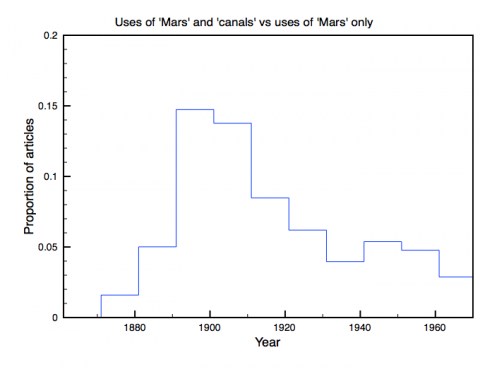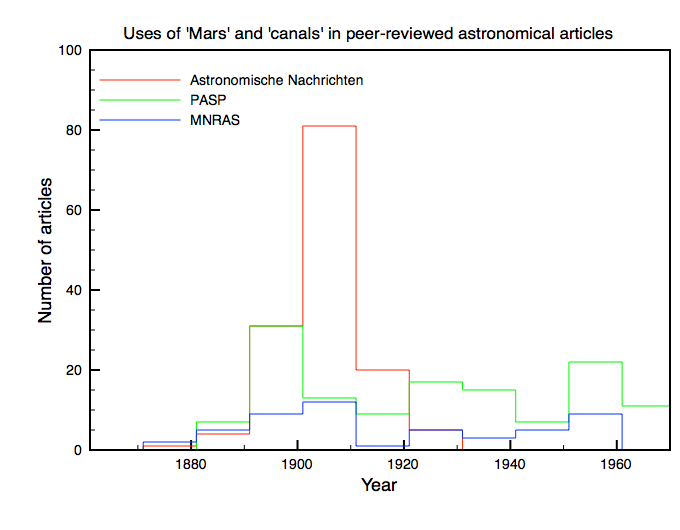In a recent, hmm, let’s call it a discussion resulting from an old post I wrote about the US Air Force’s one-time interesting in mapping Mars, I tried to assess how scientific interest in the Martian canals hypothesis lingered after the early 20th century, and said I would run up some figures to illustrate the data. So here they are.
My source is the ADSLabs Fulltext Service. ADS is the Astrophysical Data System, an online database of articles published in astronomy and physics journals. Which doesn’t sound so amazing these days, but it was in 1994 when I first used it! (More on its history here.) The interface has changed remarkably little since then, but it is still free and very comprehensive. While it is primarily an abstract service, fulltext is available for many older articles — but only as non-searchable images. Moreover, not all articles have abstracts. However, the text of articles from most of the major journals have been OCRed into a parallel database, the Fulltext Service. Like the classic ADS Abstract Service, this was not designed with historians in mind, but it’s still quite useful.
So I used the Fulltext Service to search for articles which mentioned both ‘Mars’ and ‘canals’; the algorithm is fuzzy, so it finds ‘Martian’ and ‘canal’ too. (There’s a problem with French-language journals, of which there are some, as ‘Mars’ is the French name for the month March. However, only a very small minority of articles are in French.) Of course, this does not tell us what was being said about Martian canals: it could be that they are uniformly sceptical. All it does do is crudely gauge the level of interest. I did this for ten-year bins starting from 1861 (so 1861 to 1870, 1871 to 1880, and so on) up to 1970. I chose to search only refereed journals, on the basis that these will better represent scientific interest. However, not everything in a refereed journal will necessarily be refereed itself. Also, refereed doesn’t necessarily mean professional in the astronomical sense, though the distinction mattered less in the 19th century. And it’s not really clear how complete the database is (though it does claim to go back to 1543), or the basis on which journals have been chosen. There are certainly some big gaps in the coverage, which I’ll come back to.
All of that said, what does the data show? The origins of the canals debate in the 1870s and 1880s is evident; nobody was talking about canals on Mars in the 1860s (at least, not in these journals). This makes sense, because it was Giovanni Schiaparelli’s famous announcement in 1877 that he had discovered ‘canali’ (Italian for channels or canals, though he did tend to ascribe artificiality to them) that kicked the whole thing off. The huge surge in the 1890s corresponds to the classic period of the Mars mania: Percival Lowell’s Mars was published in 1895, H. G. Wells’s The War of the Worlds in 1898 (though Wells doesn’t actually mention Martian canals, only terrestrial ones). There is a definite but not sharp decline in interest in the 1900s, which again fits: this was supposedly the last decade in which the canals hypothesis was scientifically respectable, before being discredited by E. M. Antoniadi‘s superlative observations during the Martian opposition of 1909, what Steven Dick calls ‘the Antoniadian resolution’ of the controversy: he claimed that he was finally able to resolve the canals into smaller, non-linear components. (See Steven J. Dick, The Biological Universe: The Twentieth Century Extraterrestrial Life Debate and the Limits of Science (Cambridge, New York and Melbourne: Cambridge University Press, 1998), 99.) Now, there is a sharp drop in the 1910s, but it’s still more than half the level of the preceding decade and nearly half that of the 1890s. So interest was still quite strong. It remained at that level in the 1920s, more than a decade after the canals idea was supposedly dead and buried. Only from the 1930s can interest really be said to have subsided.
But it could be that tracking the absolute number of articles discussing ‘Mars’ and ‘canal’ is misleading. The journal coverage issue is one reason for this, but also it’s possible that the rise (or fall) simply reflects a change in the number of articles published discussing ‘Mars’. So there might be more articles about Martian canals in an absolute sense but this could turn disappear when viewed as a proportion of the total scientific output on Mars. Similarly, the decline in the 20th century could just be because there was less research being done on Mars. To control for this I’ve repeated the above analysis but just for ‘Mars’ alone:
There is some correlation with the previous graph: notably, the peak is in the same place, the 1890s. But the increase in the number of articles mentioning ‘Mars’ and ‘canals’ was more rapid than those mentioning ‘Mars’ alone; and even more significantly the decline was even more rapid. In fact there was barely a decline in Mars at all — nearly as many articles mention it in the 1920s as in the 1890s. This suggests that the increase in scientific interest in the canals before 1900 or so was real and not just an artefact of Mars being a hot topic, but so, even more so, was the decline afterwards. The following plot shows this better by normalising the number of articles talking about ‘Mars’ and ‘canals’ by those talking about ‘Mars’ — in other words, showing the proportion of articles mentioning ‘Mars’ which also talk about ‘canals’:
So when Mars mania was at its height in the 1890s, 15% or about one-seventh of all peer-reviewed astronomical articles discussing ‘Mars’ (at least, those contained in the Fulltext Service) also mentioned ‘canals’. That’s actually quite impressive — though I must reiterate that this analysis says nothing about what was said about the canals, whether the articles were pro-canals, anti- or other. (At least the fact that there were zero articles in the 1860s, i.e. before Schiaparelli’s announcement, talking about both ‘Mars’ and ‘canals’ does suggest that if both terms were used in the same article they did refer to actual Martian canals, not the god Mars and earthly canals or some other accidental combination.) Looking at the data this way, the fall-off in interest in Martian canals after the 1900s is somewhat shallower than is apparent from the absolute numbers. Arguably, in fact, it remained relatively steady from the 1920s to the 1950s, with about 5% or one-twentieth of all peer-reviewed astronomical articles discussing ‘Mars’ also mentioning ‘canals’.
Overall I think all this supports my not heavily-researched contention that interest in the Martian canals hypothesis lingered after 1910, but not that the majority of astronomers believed that they actually existed right up to 1965, as some would have you believe. But there is still the problem of journal coverage, which may complicate this story slightly. As this post has grown in the writing I’ll discuss that later.
![]() This work is licensed under a Creative Commons Attribution-NonCommercial-NoDerivatives 4.0 International License.
Permissions beyond the scope of this license may be available at http://airminded.org/copyright/.
This work is licensed under a Creative Commons Attribution-NonCommercial-NoDerivatives 4.0 International License.
Permissions beyond the scope of this license may be available at http://airminded.org/copyright/.









Pingback: The canals of Mars, 1861-1970 — II
Pingback: The canals of Mars, 1861-1970 — III